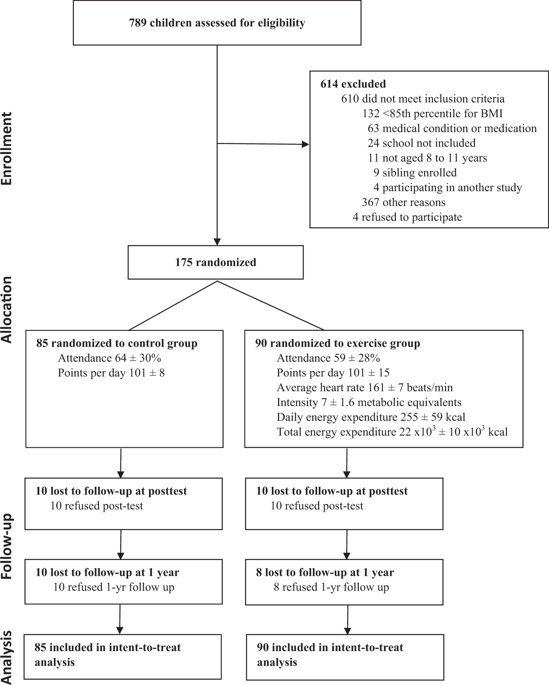当前位置:
X-MOL 学术
›
Int. J. Obesity
›
论文详情
Our official English website, www.x-mol.net, welcomes your feedback! (Note: you will need to create a separate account there.)
Exercise effects on arterial stiffness and heart health in children with excess weight: The SMART RCT.
International Journal of Obesity ( IF 4.9 ) Pub Date : 2019-11-21 , DOI: 10.1038/s41366-019-0482-1 Catherine L Davis 1, 2 , Sheldon E Litwin 3, 4 , Norman K Pollock 1, 2 , Jennifer L Waller 5 , Haidong Zhu 1, 2 , Yanbin Dong 1, 2 , Gaston Kapuku 1, 2 , Jigar Bhagatwala 1 , Ryan A Harris 1, 2 , Jacob Looney 1 , Celestine F Williams 1 , Aubrey Armento 1 , Michael D Schmidt 6 , Reda Bassali 7
International Journal of Obesity ( IF 4.9 ) Pub Date : 2019-11-21 , DOI: 10.1038/s41366-019-0482-1 Catherine L Davis 1, 2 , Sheldon E Litwin 3, 4 , Norman K Pollock 1, 2 , Jennifer L Waller 5 , Haidong Zhu 1, 2 , Yanbin Dong 1, 2 , Gaston Kapuku 1, 2 , Jigar Bhagatwala 1 , Ryan A Harris 1, 2 , Jacob Looney 1 , Celestine F Williams 1 , Aubrey Armento 1 , Michael D Schmidt 6 , Reda Bassali 7
Affiliation

|
INTRODUCTION
Childhood obesity and inactivity are associated with cardiovascular risk. Evidence is limited for exercise effects on arterial health in children.
METHODS
One hundred and seventy-five inactive children with overweight or obesity (8-11 years, ≥85th percentile BMI, 61% female, 87% Black, 73% with obesity) were randomized to an 8-month daily after-school aerobic exercise program (40 min/day, n = 90) or a sedentary control condition (n = 85). Carotid-femoral pulse wave velocity (PWV, primary outcome, arterial stiffness), fitness, adiposity, blood pressure (BP), glucose, insulin resistance, lipids, and C-reactive protein were measured at baseline and posttest (8 months). Adiposity, fitness, and BP were measured again at follow-up, 8-12 months later. Intent-to-treat analyses were conducted using mixed models.
RESULTS
The study had 89% retention, with attendance of 59% in exercise and 64% in the control condition, and vigorous exercise participation (average heart rate 161 ± 7 beats/min). Compared with controls, the exercise group had twice the improvement in fitness (VȮ2 peak, 2.7 (95% CI 1.8, 3.6) vs. 1.3 (0.4, 2.3) mL/kg/min) and adiposity (-1.8 (-2.4, -1.1) vs. -0.8 (-1.5, -0.1)%), each p = 0.04, and a large improvement in HDL-cholesterol (0.13 (0.075, 0.186) vs. -0.028 (-0.083, 0.023) mmol/L, p < 0.0001). There was no group × time effect on other outcomes at 8 months, or on any outcomes at follow-up. The change in PWV at 8 months correlated with changes in insulin and insulin resistance (both r = 0.32), diastolic BP (r = 0.24), BMI (r = 0.22), and adiposity (r = 0.18).
CONCLUSIONS
Eight months of aerobic exercise training improved fitness, adiposity, and HDL-cholesterol levels, but did not reduce arterial stiffness in children with excess weight. PWV improved as a function of insulin resistance, BP, BMI, and adiposity. Weight loss may be required to improve arterial stiffness. Exercise benefits waned after discontinuing the program.
中文翻译:

运动对超重儿童动脉僵硬度和心脏健康的影响:SMART RCT。
引言 儿童肥胖和缺乏活动与心血管风险有关。运动对儿童动脉健康的影响的证据有限。方法 175 名超重或肥胖的不活动儿童(8-11 岁,≥ 85% BMI,61% 女性,87% 黑人,73% 肥胖)随机接受为期 8 个月的每日课后有氧运动程序(40 分钟/天,n = 90)或久坐控制条件(n = 85)。在基线和测试后(8 个月)测量颈股脉搏波速度(PWV,主要结果,动脉僵硬度)、健康、肥胖、血压 (BP)、葡萄糖、胰岛素抵抗、脂质和 C 反应蛋白。8-12 个月后,在随访时再次测量肥胖、健康和血压。使用混合模型进行意向治疗分析。结果 该研究的保留率为 89%,运动出勤率为 59%,对照组为 64%,参与剧烈运动(平均心率 161 ± 7 次/分钟)。与对照组相比,运动组在健康(VȮ2 峰值,2.7(95% CI 1.8,3.6)与 1.3(0.4,2.3)mL/kg/min)和肥胖(-1.8(-2.4,- 1.1) vs. -0.8 (-1.5, -0.1)%),每个 p = 0.04,HDL-胆固醇有很大改善(0.13 (0.075, 0.186) vs. -0.028 (-0.083, 0.023) mmol/L, p < 0.0001)。对 8 个月时的其他结局或随访时的任何结局没有组×时间影响。8 个月时 PWV 的变化与胰岛素和胰岛素抵抗(均 r = 0.32)、舒张压(r = 0.24)、BMI(r = 0.22)和肥胖(r = 0.18)的变化相关。结论 八个月的有氧运动训练改善了健康,肥胖和高密度脂蛋白胆固醇水平,但并没有降低超重儿童的动脉僵硬度。PWV 作为胰岛素抵抗、BP、BMI 和肥胖的函数而改善。可能需要减轻体重以改善动脉僵硬度。停止该计划后,锻炼效果减弱。
更新日期:2019-11-22
中文翻译:

运动对超重儿童动脉僵硬度和心脏健康的影响:SMART RCT。
引言 儿童肥胖和缺乏活动与心血管风险有关。运动对儿童动脉健康的影响的证据有限。方法 175 名超重或肥胖的不活动儿童(8-11 岁,≥ 85% BMI,61% 女性,87% 黑人,73% 肥胖)随机接受为期 8 个月的每日课后有氧运动程序(40 分钟/天,n = 90)或久坐控制条件(n = 85)。在基线和测试后(8 个月)测量颈股脉搏波速度(PWV,主要结果,动脉僵硬度)、健康、肥胖、血压 (BP)、葡萄糖、胰岛素抵抗、脂质和 C 反应蛋白。8-12 个月后,在随访时再次测量肥胖、健康和血压。使用混合模型进行意向治疗分析。结果 该研究的保留率为 89%,运动出勤率为 59%,对照组为 64%,参与剧烈运动(平均心率 161 ± 7 次/分钟)。与对照组相比,运动组在健康(VȮ2 峰值,2.7(95% CI 1.8,3.6)与 1.3(0.4,2.3)mL/kg/min)和肥胖(-1.8(-2.4,- 1.1) vs. -0.8 (-1.5, -0.1)%),每个 p = 0.04,HDL-胆固醇有很大改善(0.13 (0.075, 0.186) vs. -0.028 (-0.083, 0.023) mmol/L, p < 0.0001)。对 8 个月时的其他结局或随访时的任何结局没有组×时间影响。8 个月时 PWV 的变化与胰岛素和胰岛素抵抗(均 r = 0.32)、舒张压(r = 0.24)、BMI(r = 0.22)和肥胖(r = 0.18)的变化相关。结论 八个月的有氧运动训练改善了健康,肥胖和高密度脂蛋白胆固醇水平,但并没有降低超重儿童的动脉僵硬度。PWV 作为胰岛素抵抗、BP、BMI 和肥胖的函数而改善。可能需要减轻体重以改善动脉僵硬度。停止该计划后,锻炼效果减弱。



























 京公网安备 11010802027423号
京公网安备 11010802027423号